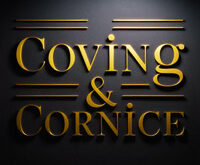You’ve likely noticed those elegant curves where your walls meet the ceiling, but have you ever considered their significance? These decorative elements, known as covings and cornices, are more than just visual embellishments. They’re a tribute to centuries of architectural history and design evolution. From ancient palaces to modern homes, these moldings have adorned interiors, adding depth, character, and a touch of sophistication. As you explore the world of interior design, you’ll discover that covings and cornices offer a unique way to elevate your space and express your personal style. But there’s more to these architectural features than meets the eye…
Historical Significance of Decorative Moldings
Throughout history, ornamental moldings have graced the interiors of esteemed buildings, reflecting the artistic and cultural values of different eras. As you explore the realm of covings and cornices, you’ll unearth a rich tapestry of architectural evolution that spans centuries.
From ancient Greek and Roman temples to Victorian mansions, these elaborate details have stood as a tribute to human creativity and craftsmanship techniques. You’ll find that each era brought its unique artistic influences, shaping the styles we still admire today. Gothic cathedrals boast intricate stone carvings, while Baroque palaces showcase extravagant stucco work.
These moldings aren’t just aesthetically pleasing additions; they’re brimming with cultural symbolism. They’ve symbolized wealth, power, and social status throughout the ages. As you explore further, you’ll appreciate how these decorative elements have become essential to historical preservation efforts.
Today, you have the freedom to choose from a wide array of styles, blending traditional and contemporary designs in your own space. By incorporating these enduring elements, you’re not just decorating – you’re connecting with centuries of artistic expression and human ingenuity. Embrace this rich heritage and make it your own.
Types of Covings and Cornices
Commonly, you’ll encounter various types of covings and cornices, each with its own distinctive style and purpose in interior design. From simple, clean lines to ornate, decorative patterns, these architectural elements offer endless design inspiration for your space.
When it comes to material options, you’re not limited to traditional plaster. Modern alternatives include lightweight polyurethane and polystyrene, which are easier to install and maintain. These materials open up a world of customization possibilities, allowing you to express your unique style without constraints.
Installation techniques vary depending on the material and complexity of the design. While DIY installation is possible for simpler styles, you might want to contemplate professional help for more intricate patterns or challenging spaces. Don’t let fear of commitment hold you back – many modern covings and cornices are removable, giving you the freedom to change your mind.
Maintenance tips are straightforward: regular dusting and occasional cleaning with a damp cloth will keep your covings and cornices looking fresh. For more elaborate designs, gentle brushing with a soft-bristled brush can help preserve intricate details.
Embrace the versatility of covings and cornices to add character and depth to your living space, reflecting your personal style and desire for freedom in design.
Modern Applications in Interior Design
Embracing modern design trends, covings and cornices have found new life in contemporary interiors, adding depth and character to minimalist spaces. You’ll find that these classic architectural elements have been reimagined to suit today’s aesthetic preferences, offering a perfect blend of tradition and innovation.
Contemporary designs now feature sleek, clean lines that complement minimalist approaches. You’re no longer limited to ornate Victorian styles; instead, you can choose from a range of subtle profiles that enhance your space without overwhelming it.

Innovative materials like lightweight polymers and eco-friendly composites have revolutionized the industry, providing you with sustainable options that are both durable and easy to install.
One of the most exciting developments is the rise of customized solutions. You’re free to create bespoke covings and cornices that perfectly match your vision, whether that’s incorporating LED lighting or experimenting with bold colors. These personalized touches allow you to break free from conventional design constraints and express your unique style.

Frequently Asked Questions
Can Covings and Cornices Be Installed in Rooms With Textured Ceilings?
You can install covings and cornices on textured ceilings, but you’ll face installation challenges. Consider texture compatibility and design options carefully. Opt for durable materials and seek professional assistance to guarantee a flawless finish that complements your unique style.
How Do You Clean and Maintain Plaster Covings and Cornices?
You’ll want to regularly dust your covings and cornices with a soft brush. For deeper cleaning, use a damp cloth with mild soap. Avoid harsh chemicals to prevent damage. For tough stains, consider professional cleaning to extend their lifespan.
Are There Eco-Friendly Alternatives to Traditional Plaster Covings and Cornices?
Yes, you’ve got eco-friendly options! Embrace sustainable materials and recycled alternatives for your covings and cornices. Explore green options made from bamboo, recycled plastic, or reclaimed wood. These eco-conscious designs let you decorate freely while respecting the planet.
Can Covings and Cornices Be Painted to Match Different Wall Colors?
You can definitely paint covings and cornices to match your walls! It’s a great DIY project that offers endless design options. Just clean them first, use proper paint, and consider textured ceilings for added flair. Customize your space freely!
What Tools Are Needed for DIY Installation of Covings and Cornices?
You’ll need a saw, adhesive, caulking gun, and measuring tape for DIY installation. Follow a step-by-step guide to avoid common mistakes. Don’t forget safety goggles and gloves. Take your time and enjoy the freedom of personalizing your space.
Conclusion
You’ve explored the rich history and diverse types of interior covings and cornices. Whether you’re aiming for classic elegance or modern sophistication, these decorative elements can transform your space.
They’re not just ornamental; they’re a reflection of your personal style. As you consider incorporating covings and cornices into your home, remember their versatility. From traditional plaster to contemporary materials, you’ll find options that suit your taste and enhance your interior design.



